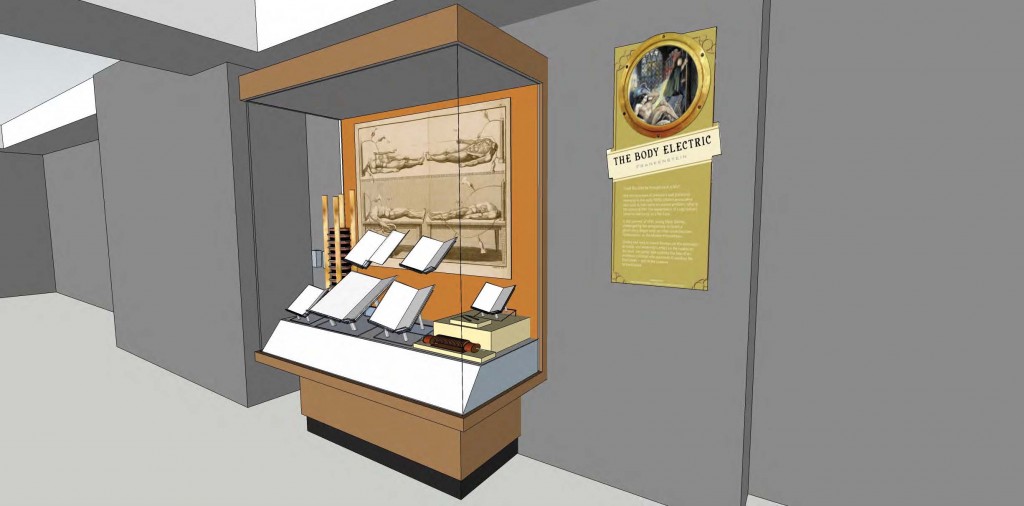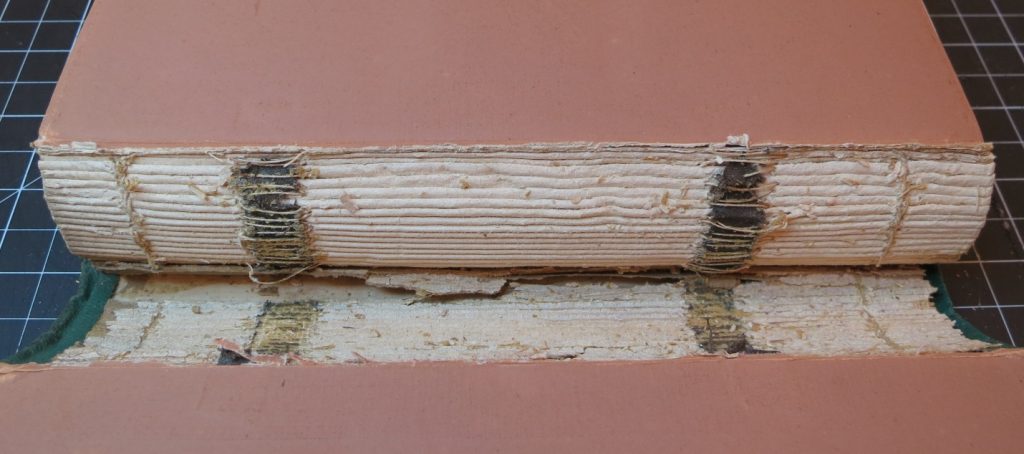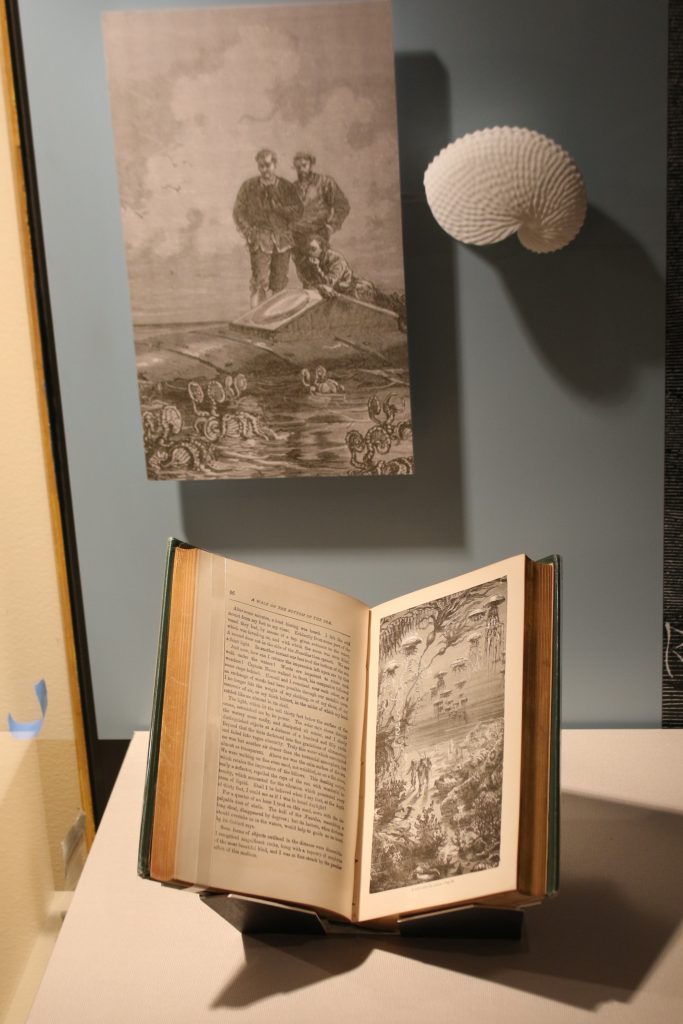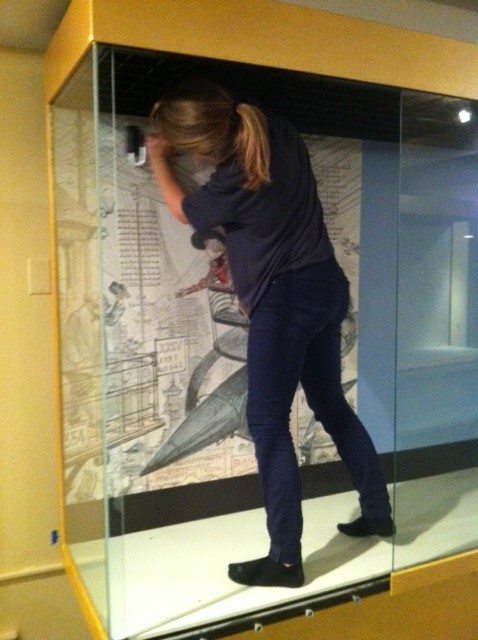
Join Smithsonian Libraries on a journey to Fantastic Worlds: Science and Fiction, 1780-1910 a new exhibition opening to the public July 1, 2015 in the Smithsonian Libraries Gallery in the newly renovated wing of the National Museum of American History. Click here for a preview.
Investigating the interplay of science and the literary imagination, Fantastic Worlds presents fascinating examples of how science fact inspired science fiction and adventure stories. Take flight with aeronauts whose exploits rival fiction. Find the truth behind the Great Moon Hoax of 1835. Discover the real life adventures that inspired Jules Verne. Examine the provocative theories that gave life to Mary Shelley’s Frankenstein. Explore the dawn of the machine age that gave rise to computers and robotics.

The making of Fantastic Worlds was a lengthy collaborative process for the co-curators who worked closely with Smithsonian Libraries exhibition coordinator Susan Frampton, the Libraries’ conservation team, the Smithsonian’s Office of Exhibits Central (OEC), and a large supporting cast. The generous financial support from Libraries board members: Carolyn J. Johnsen, Richard Q. Nye, and Kathryn C. Turner made it all possible.

Before there was Fantastic Worlds there was a concept and a lot of research. We explored scientific developments in such areas as aeronautics, geology, astronomy, natural history, and more highlighting scientific discovery and the fictions they inspired. The emerging narratives became the exhibition themes: Terra Icognita, Flights of Fancy, The Body Electric, and much more.
Books and museum objects were selected based on significance, condition, availability, and how well they supported the themes. One consideration when selecting items relating to condition was how long the book or museum object could be displayed. The amount of light exposure and physical stress a book or object can withstand, without incurring damage, helps determine how long the item can be on display.

Due to such limitations, all books and some museum objects are on a rotation schedule in which books are replaced, page openings are changed, or in some cases facsimiles are used. In order to keep the use of book facsimiles to a minimum, book loans were sought out from other libraries or private collections. In most cases, museum objects were chosen that could be used for the duration of the exhibition, with the exceptions being replaced by digital prints.

In one particular case, a specimen of an Argonauta nodosa egg case for a species of octopus, also known as a Paper nautilus, was sought-after to illustrate the role of the species in Jules Verne’s 20,000 Leagues Under the Sea. The catch was that the specimen was too fragile to be used. An elegant solution was found when the Smithsonian’s 3-D scanning team was brought in to capture the specimen for a 3-D print to use in the exhibition.
The final selection of books and objects was an iterative process that was informed by a number of considerations. What are the best stories to tell using library holdings? Do we have enough books to sustain the exhibition themes for all rotations? Is there enough space in the exhibition cases for the various book openings and objects?

For example, to tell the story of British inventor George Cayley’s development of an artificial hand we used illustrated articles from Mechanics’ Magazine and Journal of the Franklin Institute (above) along with a later reprint of the Mechanics’ article and a digital facsimile.

The process of selecting museum objects to display alongside the rare books was a fascinating one which allowed for the exploration of many intriguing Smithsonian collections. Many curators provided not only museum object loans but valuable feedback. Steve Turner from the National Museum of American History (NMAH) Medicine and Science collection provided wonderful insight and object loans from the fascinating physical sciences collection. Peggy Kidwell curator from NMAH Medicine and Science loaned the Charles Babbage difference engine model. Barney Finn and Hal Wallace from NMAH Work and Industry provided loans and expertise on the Trans-Atlantic cable were instrumental. NASM curators Roger Launius and David DeVorkin provided crucial feedback on the exhibition script. In addition, we visited a number of other Smithsonian collections and sought the insight and expertise of many curators among them: Mike Vecchione, Invertebrate Zoology (NMNH), Stephen Loring, Anthropology (NMNH), and Roger Sherman, Work and Industry (NMAH).

Putting together all the puzzle pieces of an exhibition is a truly collaborative process. The script required prolonged research, writing, and editing, which was guided by Rosemary Regan from OEC. The OEC design team lead by Betsy Burstein Robinson and Mary Bird worked arduously with the Libraries exhibition team on overall design concepts, graphics, text panels, and layout. OEC brought Fantastic Worlds to life through the design, fabrication, construction, and installation of: background graphics and reader rails for the cases, text panels for the themes, fabrication of vitrines and book supports, creation of display graphics, and installation of all these components in the gallery space.

The Smithsonian Libraries book conservation team headed by Vanessa Haight Smith and Katie Wagner were responsible for the considerable book conservation work done so that books could be displayed and digitized for use on the website. Vanessa also worked closely with OEC on the installation process including Scott Schmidt with exhibition cases and Richard Gould who specifically designed book and object cases and custom mounts and supports.

Smithsonian Libraries Digital Image Specialist David Holbert carried out the impressive undertaking of digitizing cover-to-cover a majority of the SIL books included in the exhibition with the full-text items being used in the exhibition websites digital library collection Fantastic Worlds digital library.
The website itself was team effort between Smithsonian Enterprises, Joel Richard from Smithsonian Libraries Digital Services, the exhibition coordinator, and the co-curators. The launch of the website will take place in late June so stay-tuned to Smithsonian Libraries social media for updates and mark your calendars for July 1st when the exhibition opens.

One Comment
I love this topic! ❤ Its Amazing! Thank You!